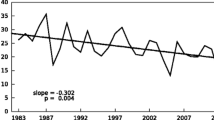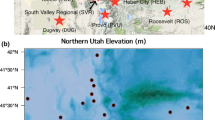Abstract
Fog has been recognised as a hazardous weather phenomenon that can cause accidents and affect urban air quality negatively. Therefore, assessing the characteristics of fog formation, as well as the changes in fog frequency and intensity as a result of climate change is of high importance. This study covers a 52-year period and contains an analysis of the frequency of fog occurring, long-term changes in fog frequency and atmospheric conditions that favour the occurrence of fog events in Latvia. During the analysis, two inter-annual maxima of fog frequency were identified in the spring and autumn; the seasonal differences in the formation of fog were also confirmed using satellite observations of low-level cloudiness. However, the long-term changes of fog frequency showed a decrease tendency of fog to form, which may be associated with improvements in air quality since industrialization and the observed increase of air temperature.







Similar content being viewed by others
References
Ahrens CD (2007) Meteorology today: an introduction to weather, climate, and the environment. Cengage Learning, Andover
Avotniece Z, Rodinov V, Lizuma L, Briede A, Klavins M (2010) Trends in the frequency of extreme climate events in Latvia. Baltica 23(2):135–148
Avotniece Z, Klavins M, Rodinov V (2013) Changes of extreme climate events in Latvia. Environ Clim Technol. doi:10.2478/v10145-012-0010-1
Bendix J (2002) A satellite-based climatology of fog and low-level stratus in Germany and adjacent areas. Atmos Res 64:3–18
Błas M, Sobik M, Quiel F, Netzel P (2002) Temporal and spatial variations of fog in the Western Sudety Mts., Poland. Atmos Res 64:19–28
Cahynova M, Huth R (2010) Circulation vs. climatic changes over the Czech Republic: a comprehensive study based on the COST733 database of atmospheric circulation classifications. Phys Chem Earth 35:422–428
Cereceda P, Osses P, Larrain H, Farias M, Lagos M, Pinto R, Schemenauer RS (2002) Advective, orographic and radiation fog in the Tarapaca Region, Chile. Atmos Res 64:261–271
Cermak J, Bendix J (2008) A novel approach to fog/low stratus detection using Meteosat 8 data. Atmos Res 87:279–292
CM SAF (2009) The Satellite Application Facility on Climate Monitoring (CM SAF). http://www.cmsaf.eu/bvbw/appmanager/bvbw/cmsafInternet Accessed 19 January 2013
COST733 (2012) Classification catalogue. http://cost733.geo.uni-augsburg.de/cost733wiki/Cost733Cat2.0 Accessed 10 January 2013
Garcia-Garcia F, Zarraluqui V (2008) A fog climatology for Mexico. Erde 139:45–60
Gerstengarbe FW, Werner PC, Rüge U (1999) Katalog der Großwetterlagen Europas (1881–1998) nach Paul Hess und Helmut Brezowsky. 5th ed. Potsdam/Offenbach. http://www.pik-potsdam.de/~uwerner/gwl/ Accessed 6 July 2014
Heo K, Ha K, Mahrt L, Shim J (2010) Comparison of advection and steam fogs: from direct observation over the sea. Atmos Res 98:426–437
Hoy A, Sepp M, Matschullat J (2013) Atmospheric circulation variability in Europe and northern Asia (1901 to 2010). Theor Appl Climatol 113(1–2):105–126
Jaagus J (2006) Climatic changes in Estonia during the second half of the 20th century in relationship with changes in large-scale atmospheric circulation. Theor Appl Climatol 83:77–88
Klavins M, Rodinov V (2010) Influence of large-scale atmospheric circulation on climate in Latvia. Boreal Environ Res 15:533–543
Kysely J (2008) Influence of the persistence of circulation patterns on warm and cold temperature anomalies in Europe: analysis over the 20th century. Global Planet Chang 62:147–163
Lange CA, Matschullat J, Zimmermann F, Sterzik G, Wienhaus O (2003) Fog frequency and chemical composition of fog water—a relevant contribution to atmospheric deposition in the Eastern Erzgebirg, Germany. Atmos Environ 37:3731–3739
Latvian Environment, Geology and Meteorology Centre (2011) Classification of hazardous meteorological phenomena
Libiseller C, Grimvall A (2002) Performance of partial Mann-Kendall test for trend detection in the presence of covariates. Environmetrics 13:71–84
Lizuma L, Briede A, Klavins M (2010) Long-term changes of precipitation in Latvia. Hydrol Res 41(3–4):241–252
Met Office (2005) The Great Smog of 1952. http://www.metoffice.gov.uk/education/teens/case-studies/great-smog Accessed 23 March 2013
Moberg A, Alexandersson H, Bergström H, Jones PD (2003) Were south Swedish summer temperature before 1860 as warm as measured? Int J Climatol 23:1495–1521
Niu S, Lu C, Yu H, Zhao L, Lü J (2010) Fog research in China: an overview. Adv Atmos Sci 27:639–662
O’Brien TA, Sloan LC, Chuang PY, Faloona IC, Johnstone JA (2012) Multidecadal simulation of coastal fog with regional climate model. Clim Dyn. doi:10.1007/s00382-012-1486-x
Sachweh M, Koepke P (1995) Radiation fog and urban climate. Geophys Res Lett 22:1073–1076
Sachweh M, Koepke P (1997) Fog dynamics in an urbanized area. Theor Appl Climatol 58:87–93
Salmi T, Määttä A, Anttila P, Ruoho-Airola T, Amnell T (2002) Detecting trends of annual values of atmospheric pollutants by the Mann-Kendall test and Sen’s slope estimates—the Excel template application MAKESENS. http://www.ilmanlaatu.fi/ilmansaasteet/julkaisu/pdf/MAKESENS-Manual_2002.pdf Accessed 24 July 2013
Shi C, Roth M, Zhang H, Li Z (2008) Impacts of urbanization on long-term fog variation in Anhui Province, China. Atmos Environ 42:8484–8492
Singh A, Dey S (2012) Influence of aerosol composition on visibility in megacity Delhi. Atmos Environ 62:367–373
Syed FS, Kornich H, Tjernstrom M (2012) On the fog variability over South Asia. Clim Dyn 39:2993–3005
Tsai YI, Kuo SC, Lee WJ, Chen CL, Chen PT (2007) Long-term visibility trends in one highly urbanized, one highly industrialized and two rural areas of Taiwan. Sci Total Environ 382:324–341
Witiw MR, LaDochy S (2008) Trends in fog frequencies in the Los Angeles Basin. Atmos Res 87:293–300
World Meteorological Organization (1992) International meteorological vocabulary. World Meteorological Organization, Geneva
Acknowledgments
We are most grateful to the Latvian Environment, Geology and Meteorology Centre for providing the meteorological observation data obtained from the surface observation network in Latvia. We would also like to thank the CM SAF project of EUMETSAT for providing satellite observation data and COST Action 733 for the atmospheric circulation data used in this study. This study was realised using the financial support of the Latvian Council of Science (Grant No. 526/2013).
Author information
Authors and Affiliations
Corresponding author
Rights and permissions
About this article
Cite this article
Avotniece, Z., Klavins, M. & Lizuma, L. Fog climatology in Latvia. Theor Appl Climatol 122, 97–109 (2015). https://doi.org/10.1007/s00704-014-1270-4
Received:
Accepted:
Published:
Issue Date:
DOI: https://doi.org/10.1007/s00704-014-1270-4




